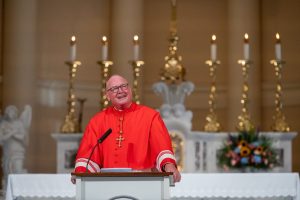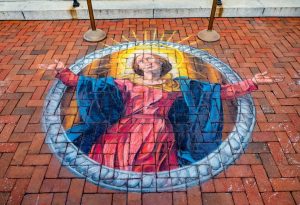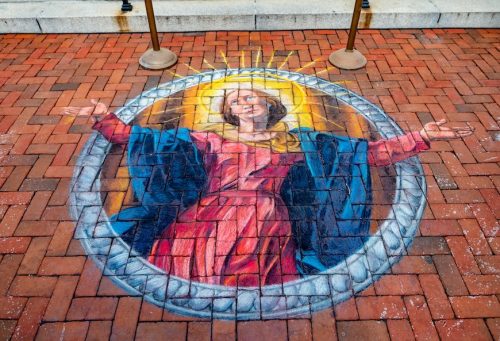By Christopher Gunty | Catholic News Service
BALTIMORE (CNS) — For a special vespers and Mass to mark the patronal feast of Baltimore’s Basilica of the Assumption of the Blessed Virgin Mary during its 200th anniversary year, Archbishop William E. Lori appropriately used the crosier that belonged to Archbishop Ambrose Maréchal.
Archbishop Maréchal, the third archbishop of Baltimore, presided at the dedication of America’s first cathedral in 1821.
The celebrations featured a talk on the history of the basilica and the first bishop in the U.S. by Cardinal Timothy M. Dolan of New York and a homily about Mary’s role in our faith by Los Angeles Auxiliary Bishop Robert E. Barron.
The history of the basilica was the focus for vespers Aug. 14, the vigil of the feast of the Assumption, with a talk delivered by Cardinal Dolan, whose doctoral studies focused on the history of the American church.

The cardinal started his talk quoting from the fifth chapter of Matthew’s Gospel: “You are the light of the world. A city set on a hill cannot be hidden.” He said he believed Archbishop John Carroll, the first bishop in the United States, had precisely this in mind when he made plans for the first cathedral to be built in the newly minted country.
He said the basilica is the closest thing the Catholic Church in the U.S. has to Independence Hall, Mount Rushmore and the Baseball Hall of Fame in Cooperstown, New York.
Archbishop Carroll, a “realistic dreamer,” intended the new cathedral to be “a light to the nation, a light to the world,” the cardinal said.
He was consecrated on the feast of the Assumption in 1790 as the first bishop of Baltimore, and what was a diocese at the time encompassed everything in the U.S. from the Atlantic to the Mississippi River.
Then-Bishop Carroll wanted to move from a “quiet Catholicism” that had been loyal to the crown, and whose faith would be mostly private, to a “Maryland-style Catholicism” that was more open and engaged with society.
Archbishop Carroll — elevated to archbishop by Pope Pius VII when he made Baltimore the first U.S. archdiocese in 1808 — was pleased to see a number of Catholics involved in the political realm, including his brother, Daniel Carroll, one of only five men to sign both the Articles of Confederation and the U.S. Constitution.
Their cousin, Charles Carroll of Carrollton, the last surviving signer of the Declaration of Independence, was elected to the Maryland Senate. All three Carrolls studied at the Jesuit college in Saint-Omer, France.
Cardinal Dolan noted this new style of Catholicism was patriotic; homegrown, that is, not ecclesiastically European; and educated, for which the first archbishop opened Georgetown University as the first Catholic institution of higher learning in the U.S. The prelate also wanted a new cathedral, rather than designating an existing church for the seat of the archbishop.
“He wanted the best, on a high hill,” Cardinal Dolan said, and for that he wanted the best architect who could design an edifice that would say, “We are Catholic and we are here to stay.”
For that task, he selected Benjamin Henry Latrobe, who had designed the U.S. Capitol. He built a cathedral that was the most advanced building in the country at the time.

But it is the “living stones” — the people — that make the Baltimore Basilica come alive, Cardinal Dolan noted. “From this altar, the light shines.”
Officially called the Basilica of the National Shrine of the Assumption of the Blessed Virgin Mary, the nation’s first cathedral was elevated to a minor basilica by Pope Pius XI in 1937. In 1972, it was declared a National Landmark, and in 1993, the U.S. bishops’ conference designated it a national shrine.
Cardinal Dolan noted that archbishops of Baltimore from Cardinal James Gibbons through Cardinal Lawrence Shehan and Archbishop Lori, have made social justice a hallmark. He noted that Father James Boric, current rector of the basilica, has created an urban street ministry, the Source of All Hope, that goes out into the streets of the city to minister to and with those experiencing homelessness.
The following day, Archbishop Lori celebrated Mass for the feast day, with Bishop Barron as the homilist. The bishop said he could not decline the invitation to preach in “the most beautiful church in America, and one with unparalleled historical resonance.”
The bishop, who also is the founder of Word on Fire Catholic Ministries, noted that when he was a doctoral student in Paris, he conducted tours of Notre Dame Cathedral for English-speakers every Wednesday.
“One of my favorite stops on those tours was at the left portal on the facade of the cathedral,” he said, “where I would always point out the curious juxtaposition of a statue of Mary, the mother of God, with a depiction of the Ark of the Covenant.”
He said the juxtaposition showed that Mary, who carried the Word of God in her womb, was “the Ark of the Covenant par excellence.”
He paralleled the readings from the Mass, which indicated that the Ark was taken to “the hill country of Judah,” the same place referenced when Mary visits her cousin, Elizabeth. He noted that King David danced with abandon before the Ark of the Covenant, and John the Baptist, in Elizabeth’s womb, “performs his own David-like dance” in the presence of Mary, the true Ark.
“The point is clear. The true vessel in which it pleased the God of Israel in his fullness to dwell is none other than Mary, the Mother of God,” Bishop Barron said.
Reflecting on the reading for the feast from the Book of Revelation, he said that the author’s narrative shows that Mary is the Queen of Heaven, and a warrior queen battling the powers of darkness. This alludes also to the Ark of the Covenant, because the Israelites often took the Ark with them into battle, convinced it would act as a conduit of God’s power against the enemies of the nation.
“Therefore, the true Ark, Mary, the mother of God, also serves as a conduit of God’s mighty power against those forces that will threaten us.”
He noted that Mary’s Assumption into Heaven does not indicate that Mary has abandoned us, “it means she’s gone to a higher point of advantage, where, like a military commander, she can observe the entire field of battle.”
She involves herself in a battle not “fought with worldly weapons,” but with the “divine method of warfare — fighting evil with good, violence with nonviolence, hatred with self-emptying love, cruelty with forgiveness.”
This battle goes on through the ages, Bishop Barron said, so today’s struggle “between the forces of light and the forces of darkness between what St. John Paul II called the culture of life and the culture of death should not surprise us.”
“There’s no question that in our contemporary Western culture,” he said, “there’s a sharply diminished sense of the inherent dignity of the human person.” He pointed to the acceptance in some quarters of capital punishment, racism, “the murderous violence in our streets,” homeless encampments, indifference to the elderly, illustrated by laws permitting euthanasia and “an unwelcoming attitude” to those seeking asylum in our country.
“And we can see it with perhaps greatest clarity in the abortion license that permits the murdering of 1 million unborn children a year. The dysfunction that lies behind all of these outrages is the instrumentalization of human life, the reduction of the person to the level of a means to an end.”
He said that thinking is repugnant to the biblical teaching that each human being is made in the image and likeness of God and is why Mary, the warrior queen, is presented in the Book of Revelation as pregnant, a bearer of life.
“To fight under her leadership and according to her example is therefore to fight on behalf of life, defending those whose dignity and very survival are most threatened,” Bishop Barron said, adding that “the dragon is powerful indeed” but “the Queen of Heaven is more powerful still.”
On the feast of the Assumption, “in this splendid place, the mother church of American Catholicism,” Bishop Barron said, “we recommit ourselves to be happy warriors under the banner of the Queen of Heaven, the true Ark of the Covenant, fighting for life and fighting for truth.”






















